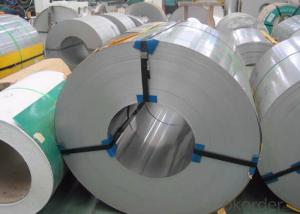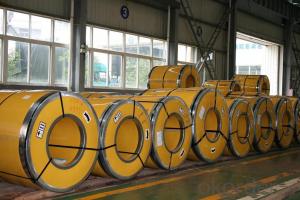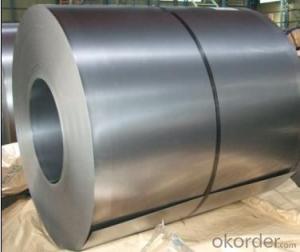201 SERIOUS HOT ROLLED STAINLESS STEEL COILS/SHEETS
- Loading Port:
- Shanghai
- Payment Terms:
- TT OR LC
- Min Order Qty:
- 100 m.t.
- Supply Capability:
- 20000 m.t./month
OKorder Service Pledge
OKorder Financial Service
You Might Also Like
Quick Details
| Grade: | 2B | Standard: | JIS,AISI,GB | Length: | as customers' requested |
| Thickness: | 2.5mm;3.0mm;4.0mm or as required | Width: | 485mm,510mm,600mm or as required | Place of Origin: | China (Mainland) |
| Brand Name: | CNBM | Model Number: | 201 | Type: | Coil |
| Application: | Decoration,Boiler Plate,Chemical Industry,Container plate,ship | Certification: | SGS,ISO | Color: | natural color |
| Available Finish: | 2B/BA/8K/No.4/SB/HL | Edge: | slit edge and mill edge | Features: | accurate dimensions |
| Manufacture technology: | cold drawn,pickling, hot rolled and cold rolled | DDQ: | slivery bright surface | Quality: | high quality Hot rolled stainless steel coil 201 |
| Stock: | Always in stock | Item: | Hot rolled stainless steel coil 201 |
Packaging & Delivery
| Packaging Detail: | Standard export packing or as customer's requirement Hot rolled stainless steel coil 201 |
| Delivery Detail: | In 15 days |
Specifications
Hot rolled stainless steel coil 201
Width:485mm,510mm,600mm or as required
Thickness: 2.5mm;3.0mm;4.0mm or as required
Product Description
Stainless steel coil; stainless steel cold rolled coil;201 stainless steel coil; stainless steel coil
A. stainless steel coil
B. with competitive prices and fast delivery
C. High quality
Tisco 201 stainless steel coil
Thickness: 2.5mm;3.0mm;4.0mm or as required
Width: 485mm,510mm,600mm or as required
Length: As required
Material:201
201 stainless steel coil chemical composition
201 stainless steel coil | ||||||||
Grade | Chemical composition | |||||||
C | Si | Mn | P | S | Ni | N | Cr | |
% | % | % | % | % | % | % | % | |
201 | ≤0.15 | ≤0.75 | 5.5~7.50 | ≤0.060 | ≤0.030 | 3.50~5.50 | ≤0.25 | 16.00-18.00 |
201 stainless steel coil physical property
Physical Property | ||||
density | Strength of extension | yield strength | elongation | modulus of elasticity |
g/cm³ | psi | psi | % | psi |
7.93 | 100000-180000 | 50000-15000 | 55-60 | 29000000 |
Item | 201 stainless steel coil |
Technical | Hot rolled and cold rolled |
Standard | ASTM A240,GB/T3280-2007,JIS4304-2005,ASTM A167,EN10088-2-2005,GB/T3280-2007,EN10095-99,JIS4312,etc |
Material | 201,202,304,304L,309S,310S,316,316L,316Ti,430 |
Surface | NO.1,2b,4K,8k,HL,mirror finish |
Thickness | 0.3-100mm |
Width | 500-2000mm |
Price term | FOB,CFR,CIF |
Application | Stainless steel coil applies to construction field, ships building industry, petroleum, chemical industries, war and electricity industries, food processing and medical industry, boiler heat exchanger, machinery and hardware fields. Stainless steel coil can be made according to the customer’s requirements. |
Contact | If you have any question, please feel free to contact me. |
- Q:What's the difference between stainless steel coil and stainless steel plate?
- One is a coil and the other is a strip.
- Q:Can stainless steel strips be used for heat exchanger plates?
- Yes, stainless steel strips can be used for heat exchanger plates. Stainless steel is a highly durable and corrosion-resistant material, making it suitable for use in heat exchangers. The strips can be easily formed into plates of various shapes and sizes, providing flexibility in design and installation. Additionally, stainless steel has excellent thermal conductivity, ensuring efficient heat transfer between fluids. Overall, stainless steel strips are a popular choice for heat exchanger plates due to their strength, resistance to corrosion, and thermal conductivity properties.
- Q:Can stainless steel strips be used in the chemical industry?
- Yes, stainless steel strips can be used in the chemical industry. Stainless steel is known for its excellent corrosion resistance, which makes it an ideal choice for use in environments where there are chemicals present. It can withstand exposure to various chemicals, acids, and alkalis, making it suitable for applications such as chemical storage tanks, pipes, valves, and fittings. Additionally, stainless steel strips are durable, easy to clean, and maintain their strength and integrity even in harsh chemical environments. Therefore, they are widely used in the chemical industry for their reliability and longevity.
- Q:Do stainless steel strips require any special handling or storage?
- Yes, stainless steel strips do require special handling and storage to maintain their quality and prevent damage. Here are some key considerations: 1. Handling: Stainless steel strips should be handled with care to avoid scratches, dents, or other forms of physical damage. It is recommended to use gloves and protective equipment to prevent any contamination from oils, dirt, or fingerprints. 2. Storage: Stainless steel strips should be stored in a clean, dry, and well-ventilated area to prevent corrosion. They should be kept away from moisture, chemicals, and any other substances that could cause damage. Ideally, the storage location should have a controlled temperature and humidity level. 3. Protection: To ensure the longevity of stainless steel strips, they should be protected from contact with other metals or abrasive materials. Storing them separately or using appropriate packaging, such as plastic or paper interleaved between the strips, can help prevent scratches or other damages. 4. Handling equipment: When moving or transporting stainless steel strips, it is advisable to use equipment specifically designed for handling metal products. This can include lifting devices, slings, or clamps that ensure proper support and avoid any bending or deformation of the strips. 5. Regular inspection: Regularly inspecting stainless steel strips for any signs of damage, corrosion, or deterioration is essential. Any issues should be addressed promptly to prevent further degradation and maintain the quality of the strips. By following these guidelines, stainless steel strips can be stored and handled properly, ensuring their integrity and allowing for their successful application in various industries.
- Q:Can stainless steel strips be coated or painted?
- Yes, stainless steel strips can be coated or painted.
- Q:Can stainless steel strips be used for architectural signage?
- Architectural signage can indeed utilize stainless steel strips. Due to its durability and versatility, stainless steel is commonly employed in architectural applications as it possesses strength and resistance to corrosion. It is capable of being easily molded into different shapes and sizes, making it suitable for creating signage with various designs and dimensions. Additionally, stainless steel is renowned for its aesthetic appeal, as its polished finish offers a sleek and modern appearance. This feature makes it a popular choice for architectural signage, as it can enhance the overall look of a building or space. Furthermore, stainless steel is a low-maintenance material that can endure harsh weather conditions, ensuring that the signage remains in excellent condition for an extended period. In summary, stainless steel strips are a dependable and visually appealing option for architectural signage.
- Q:Are stainless steel strips suitable for high-temperature exhaust systems?
- Yes, stainless steel strips are suitable for high-temperature exhaust systems. Stainless steel is known for its excellent heat resistance and durability, making it an ideal material choice for exhaust systems that operate at high temperatures. It can withstand the intense heat generated by the exhaust gases without warping or corroding, ensuring long-lasting performance and reliability.
- Q:What is the thermal conductivity of stainless steel strips at different temperatures?
- The thermal conductivity of stainless steel strips can differ based on the particular grade of stainless steel and the temperature at which it is measured. Nonetheless, stainless steel is generally recognized for its relatively lower thermal conductivity in comparison to other metals. Typically, at room temperature (approximately 25°C or 77°F), the thermal conductivity of stainless steel strips falls within the range of 14 to 19 watts per meter-kelvin (W/m·K). As the temperature rises, the thermal conductivity of stainless steel tends to exhibit a slight decrease. As an illustration, when exposed to elevated temperatures like 200°C (392°F), the thermal conductivity of stainless steel might decline to about 12 to 17 W/m·K. Similarly, at exceedingly high temperatures such as 1000°C (1832°F), the thermal conductivity of stainless steel can further decrease to around 8 to 12 W/m·K. It is crucial to bear in mind that these values are approximate and can fluctuate depending on factors such as the specific alloy composition, impurities, and manufacturing processes employed in the production of the stainless steel strips. Therefore, for precise and accurate thermal conductivity values at different temperatures, it is advisable to refer to the technical datasheet or get in touch with the manufacturer of the specific stainless steel strip being utilized.
- Q:Are stainless steel strips suitable for automotive trim applications?
- Yes, stainless steel strips are suitable for automotive trim applications. Stainless steel is known for its durability, corrosion resistance, and aesthetic appeal, making it an excellent choice for automotive trim. It can withstand harsh weather conditions, exposure to chemicals, and impacts, ensuring that it remains in good condition for a long time. Additionally, stainless steel strips offer a sleek and polished appearance, enhancing the overall look of the vehicle. They are also easy to maintain and clean, making them a practical choice for automotive trim applications.
- Q:Can stainless steel strips be used in high-temperature applications?
- Certainly! High-temperature applications can indeed utilize stainless steel strips. Renowned for its impressive heat resistance, stainless steel is capable of enduring elevated temperatures while maintaining both its strength and structural integrity. With a high melting point and minimal thermal expansion, stainless steel proves to be an excellent choice for environments characterized by heightened temperatures. Moreover, its resistance to oxidation and corrosion further enhances its aptness for high-temperature applications. Industries such as aerospace, automotive, chemical, and power generation frequently employ stainless steel strips in order to withstand extreme temperatures and challenging conditions.
1. Manufacturer Overview |
|
|---|---|
| Location | |
| Year Established | |
| Annual Output Value | |
| Main Markets | |
| Company Certifications | |
2. Manufacturer Certificates |
|
|---|---|
| a) Certification Name | |
| Range | |
| Reference | |
| Validity Period | |
3. Manufacturer Capability |
|
|---|---|
| a)Trade Capacity | |
| Nearest Port | |
| Export Percentage | |
| No.of Employees in Trade Department | |
| Language Spoken: | |
| b)Factory Information | |
| Factory Size: | |
| No. of Production Lines | |
| Contract Manufacturing | |
| Product Price Range | |
Send your message to us
201 SERIOUS HOT ROLLED STAINLESS STEEL COILS/SHEETS
- Loading Port:
- Shanghai
- Payment Terms:
- TT OR LC
- Min Order Qty:
- 100 m.t.
- Supply Capability:
- 20000 m.t./month
OKorder Service Pledge
OKorder Financial Service
Similar products
New products
Hot products
Hot Searches
Related keywords






























